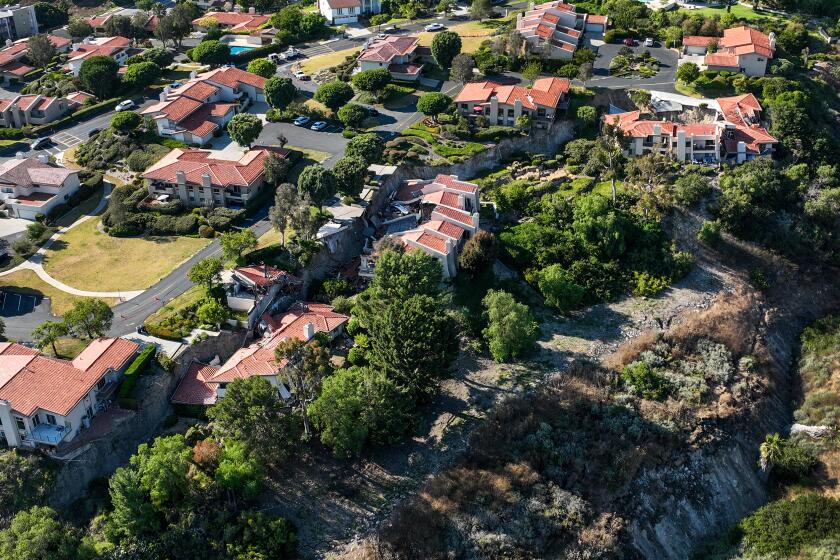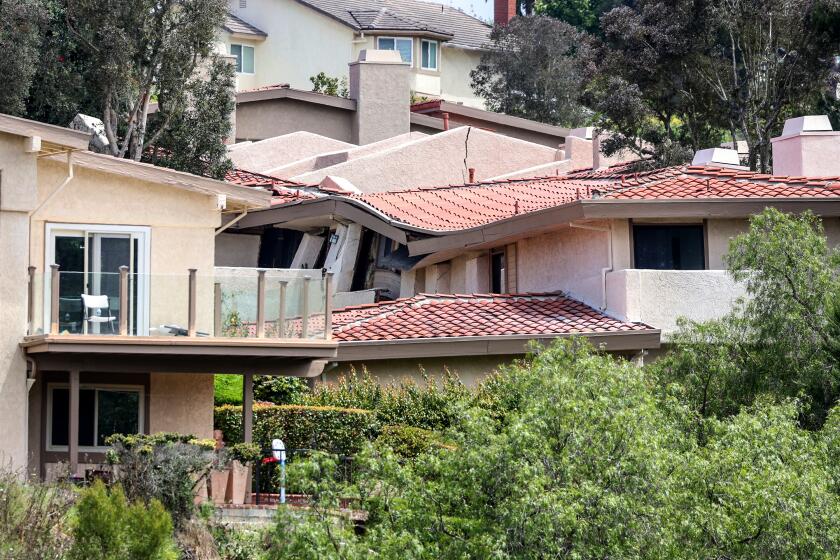Is a 1976 drainage plan to blame for 2023 Rolling Hills Estates landslide? Homeowners’ lawsuit says yes

- Share via
In 1976, as the city of Rolling Hills Estates considered plans for a new development on the Palos Verdes Peninsula, officials debated how water should drain through a nearby canyon.
The development would cause increased runoff, city officials noted at the time, which would ideally be maintained by the Los Angeles County Flood Control District.
But one other factor was paramount.
“It is recommended that all efforts be made to obtain that [flood control] district’s acceptance,” the city’s resolution from August 1976 said. “However, this should not be done if it requires installation of concrete channels through the canyon bottoms which would defeat the intent of the natural area.”
And so, the drainage plan remained as outlined — failing to meet the flood control district’s requirements and leaving drainage to the purview of the development’s homeowners’ associations, the records said.
Rolling Hills Estates aims to shore up the slope that failed in July and destroyed eight homes. But as winter approaches, residents fear heavy rain and renewed disaster.
That decades-old decision is now the linchpin of a lawsuit that claims the city, county and homeowners’ associations failed to properly manage runoff in that canyon, a section of which would go on to collapse in July 2023, destroying several homes and damaging others in the Peartree Lane landslide.
“The stormwater directed by the county and city drainage facilities into the canyon eroded and down-cut the toe of the slope, causing it to fail in July 2023,” a group of affected homeowners alleged in the lawsuit’s updated complaint. “The city and county deliberately ignored their standard because they preferred the aesthetic beauty of a natural (i.e., unprotected) channel.”
The lawsuit alleges that the drainage decision, made while officials knew that the Palos Verdes Peninsula was landslide-prone, was mishandled and ultimately led to the landslide. The hillside collapse destroyed eight homes and left several others unsafe for inhabitants, just hours after firefighters evacuated families. No one was injured.
City and county officials “knew or should have known that the proposed Park Community and other developments in the watershed area would significantly increase the stormwater flow in the open canyon drainage channel, and that the increased stormwater flow would erode, down-cut, and destabilize the hillside on which plaintiffs’ homes would be built,” says the new complaint, which was filed this month.
The city of Rolling Hills Estates, which concluded that extreme rains from the prior winter caused the landslide, rebutted the lawsuit’s claims.
“At this point, we’re not aware of any city infrastructure or city activity that contributed to the landslide,” said Ed Richards, an attorney representing the city in the lawsuit. He declined to comment on specifics in the case because the litigation remains ongoing.
From the late 1970s to early 1980s, officials monitored the development of Rolling Hills Park Villas, where a landslide has since ruined at least eight homes.
Lawyers for the county and the homeowners’ associations didn’t immediately respond to requests for comment, but have denied similar allegations in previous lawsuits.
Earlier this year, another group of residents whose homes were destroyed or damaged in the landslide filed a similar lawsuit, which also remains ongoing. A judge ruled earlier this month that the two cases were related and they could soon be consolidated.
In that other case, the residents alleged that “due to the design and/or maintenance” of the storm water system, it failed and led to the landslide.
Ken Kasdan and Scott Thomson, attorneys for that group of residents, said they hired experts who conducted on-site assessments, finding that the way water funneled into the canyon “contributed to the slope failure.”
A report prepared for Rolling Hills Estates says excessive rainfall caused the landslide in July that destroyed eight homes, but some residents are skeptical of the city’s findings.
The group has also filed a third lawsuit, alleging the two homeowners’ associations in the community, Rolling Hills Park Community Assn. and Rolling Hills Park Villas Assn., failed “to conduct reasonable inspection, repair, preservation, erosion and sliding prevention, and monitoring of the slope which resulted in the damage.” That case also remains open.
Before construction on this development began, a city engineer in 1976 wrote to Rolling Hills Estates leaders, noting that it was important “to ascertain if any consequences exist in this area as a result of subsidence similar to that which is being experienced in some of the adjacent beach areas,” which the most recent complaint said was in reference to the Portuguese Bend landslide.
At that point, the Portuguese Bend landslide — a few miles southeast from the proposed development — had been slowly pushing land toward the sea for two decades, triggered in 1956 by nearby construction, and initially destroyed dozens of homes. (That landslide remains an issue in Rancho Palos Verdes, which borders Rolling Hills Estates.)
“In spite of the risk of subsidence, [Rolling Hills Estates] insisted on draining stormwater across steep slopes into the open canyon drainage channel,” the updated complaint said. “It chose not to build concrete channels.”
More to Read
Sign up for Essential California
The most important California stories and recommendations in your inbox every morning.
You may occasionally receive promotional content from the Los Angeles Times.














